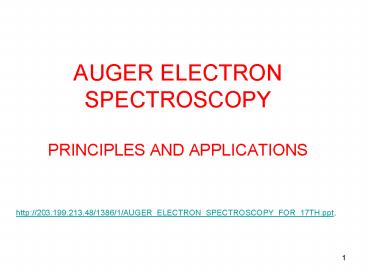AUGER ELECTRON SPECTROSCOPY PRINCIPLES AND APPLICATIONS - PowerPoint PPT Presentation
1 / 26
Title:
AUGER ELECTRON SPECTROSCOPY PRINCIPLES AND APPLICATIONS
Description:
AUGER ELECTRON SPECTROSCOPY PRINCIPLES AND APPLICATIONS http://203.199.213.48/1386/1/AUGER_ELECTRON_SPECTROSCOPY_FOR_17TH.ppt. * * Auger Electron Spectroscopy Auger ... – PowerPoint PPT presentation
Number of Views:1313
Avg rating:3.0/5.0
Title: AUGER ELECTRON SPECTROSCOPY PRINCIPLES AND APPLICATIONS
1
AUGER ELECTRON SPECTROSCOPY PRINCIPLES AND
APPLICATIONS
http//203.199.213.48/1386/1/AUGER_ELECTRON_SPECTR
OSCOPY_FOR_17TH.ppt.
2
Auger Electron Spectroscopy
- Auger Electron Spectroscopy (AES), is a widely
used technique to investigate the composition of
surfaces. - First discovered in 1923 by Lise Meitner and
later independently discovered once again in 1925
by Pierre Auger 1
Lise Meitner
Pierre Victor Auger
1. P. Auger, J. Phys. Radium, 6, 205 (1925).
3
Particle-Surface Interactions
- Auger Electron Spectroscopy
Ions Electrons Photons
Ions Electrons Photons
Vacuum
4
Basic theory
- Auger spectroscopy can be considered as involving
three basic steps - (1) Atomic ionization (by removal of a core
electron) - (2) Electron emission (the Auger process)
- (3) Analysis of the emitted Auger electrons
- This last stage is simply a technical problem of
detecting charged particles with high
sensitivity, with the additional requirement that
the kinetic energies of the emitted electrons
must be determined.
5
Photoelectron vs. Auger Electron Emission
6
Auger Electron Spectroscopy
7
Physics basis
- An Auger transition is therefore characterized
primarily by - - the location of the initial hole
- the location of the final two holes
In general, since the initial ionisation is
non-selective and the initial hole may therefore
be in various shells, there will be many possible
Auger transitions for a given element - some
weak, some strong in intensity. AUGER
SPECTROSCOPY is based upon the measurement of the
kinetic energies of the emitted electrons. Each
element in a sample being studied will give rise
to a characteristic spectrum of peaks at various
kinetic energies.
This is an Auger spectrum of Pd metal -
generated using a 2.5 keV electron beam to
produce the initial core vacancies and hence to
stimulate the Auger emission process. The main
peaks for palladium occur between 220 340 eV.
The peaks are situated on a high background which
arises from the vast number of so-called
secondary electrons generated by a multitude of
inelastic scattering processes. Auger spectra
are also often shown in a differentiated form
the reasons for this are partly historical,
partly because it is possible to actually measure
spectra directly in this form and by doing so get
a better sensitivity for detection. The plot
below shows the same spectrum in such a
differentiated form.
High secondary electron background
8
INSTRUMENTATION
- Main Features of the Laboratory's JAMP 9500F AES
Capability - Quantitative analysis of elements except hydrogen
and helium - Typical element detection limits are 0.1 atomic
from the top few nm (2-5) - SEM (scanning electron microscopy)
- Scanning Auger Microscopy (SAM) allows surface
chemical maps to be collected with lateral
resolutions better than 10nm. - Chemical state information of certain elements
(particularly Al, Mg, Si etc.) can be obtained - Sputter depth profiling reveals chemical depth
information - Samples can be conductors and semiconductors.
Analysis of insulators is more difficult but
possible
9
The System available at VUB-SURF JEOL9500 F
Capabilities ? Elemental composition in a
sampling depth that can attain 20 Å. ? Detection
of elements heavier than Li. Very good
sensitivity for light elements. ? Depth
profiling, with depth resolution around 20 Å. ?
Spatial distribution of the elements (Auger maps
or analysis in lines, points and areas) ?
Secondary electron images with spatial resolution
down to 10 nm. ? Backscattered electrons
imaging. Energy resolution 0.06 compared to
0.1 for most systems Limitations ? Samples
must be conductive. ? Possibility of beam damage
of some surfaces ? Hydrogen and helium are not
detectable. ? Quantitative detection is dependent
on the element light elements gt 0.1 heavier
elements gt 1. ? Accuracy of quantitative
analysis depending on the availability of
adequate sensitivity factors. Best accuracy
10. Analysis requirements ? AES - Conductive
materials. Flat specimens max. diameter 2 cm and
max. height 1 cm ? Specimen surface not
handled. Samples must be clean and free of
organics or high vapour pressure contaminants. ?
Samples are first analysed as received and
after a short etching to ensure that all
contaminants are removed. ? Surface elemental
composition and quantification takes less than 1
hour. ? Depth profiling, Auger imaging with
high-resolution curve fitting require analysis
time between 1 and 5 hours.
10
SITE DIFFERENTIATION
11
(No Transcript)
12
Surface Analysis Depths
13
Scanning Auger Electron Spectrometer
14
(No Transcript)
15
Elemental Shifts
L. E. Davis, N. C. MacDonald, Paul W. Palmberg,
G. E. Riach, R. E. Weber, Handbook of Auger
Electron Spectroscopy, 2nd Edition, Physical
Electronics Division, Perkin-Elmer Corp., Eden
Prairie, MN 1976.
16
Quantitative surface analysis AES
- By assuming the concentration to be a relative
ratio of atoms, - we can neglect the terms that depend only on the
instrument - The values of S are determined theoretically or
empirically with standards. - AES is considered to be a semi-quantitative
technique
17
Quantitative surface analysis AES
18
Auger Analysis Examples A - Chemical
composition, thickness and spatial distribution
of the elements on cerium conversion layers
deposited on galvanised steel. Effect of the
treatment time (30 minutes and 24 hours)
19
AES Depth Profiling An Example
(cross section)
20
AES Depth Profiling An Example
21
Imaging
Electron Beam in combination with an SED detector
allows for imaging of the sample to select the
area for analysis
Fracture surface of Carbon fibers
22
Chemical Shift
23
Semiconductor Doping Shift in AES
24
Doping Map by AES
25
(No Transcript)
26
THANK YOUIf we knew what we were doing, It
wouldn't be research, now would it?Albert
Einstein (1879-1955)

